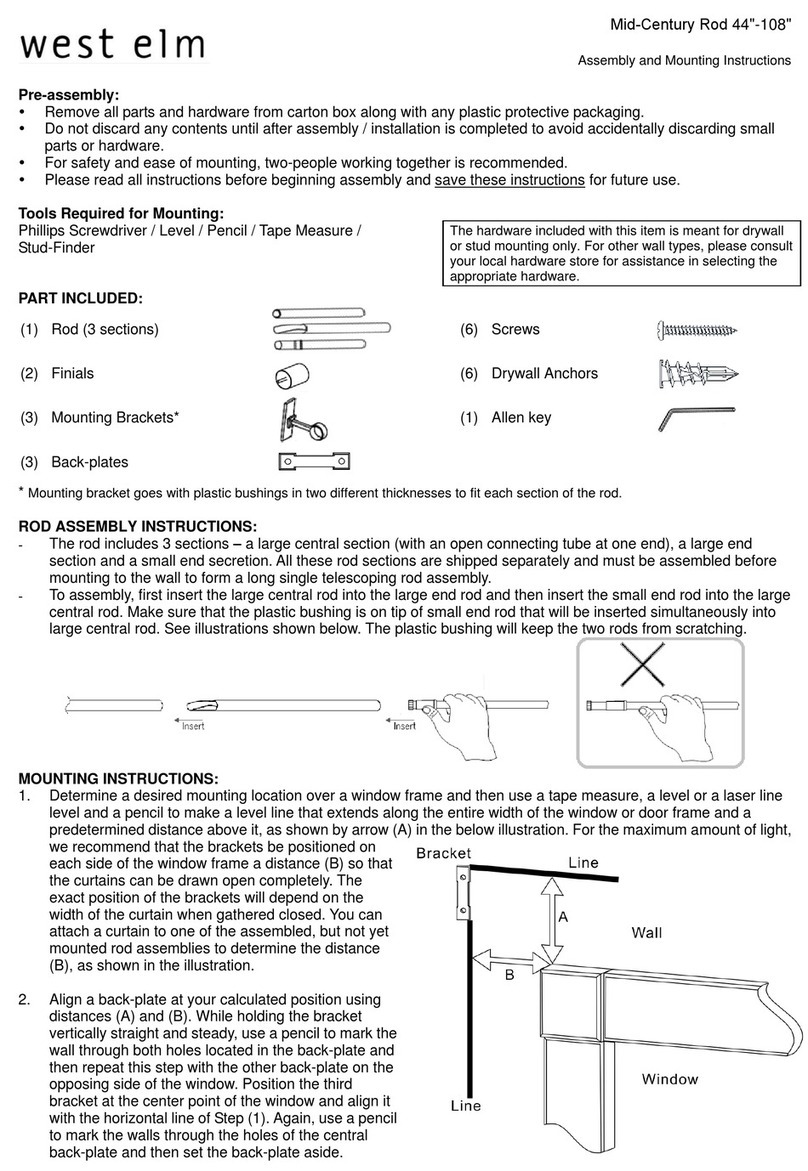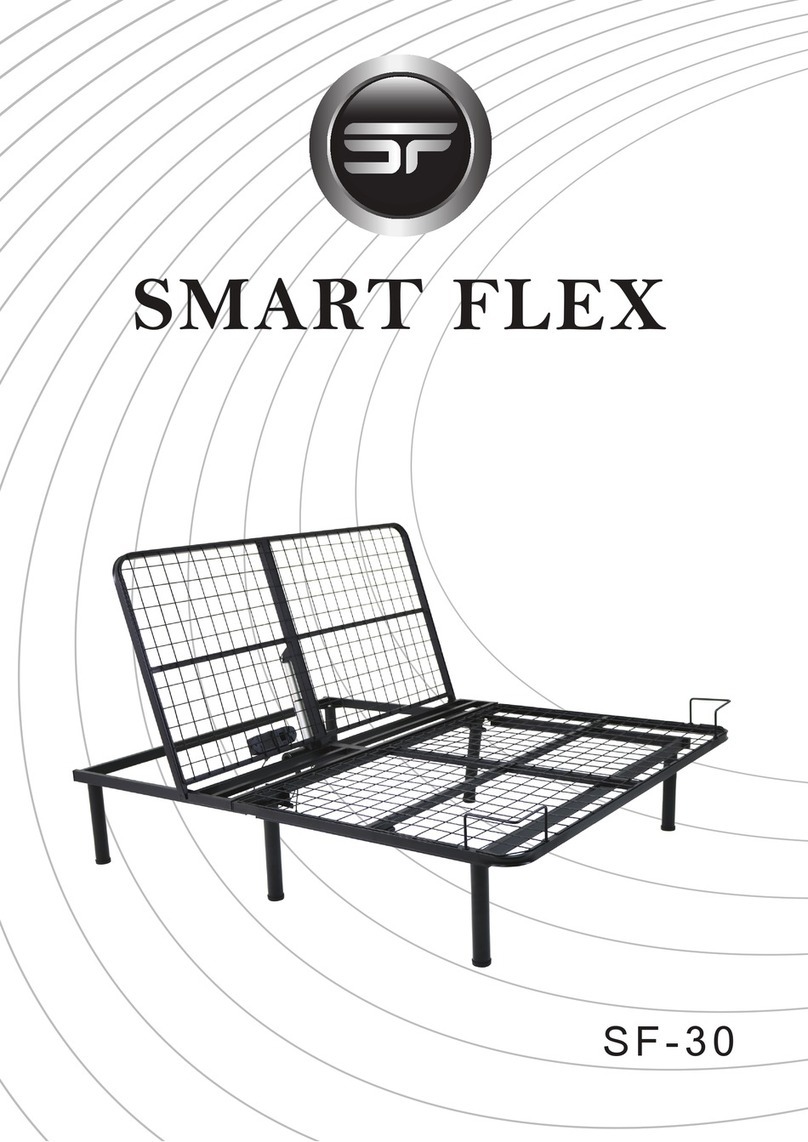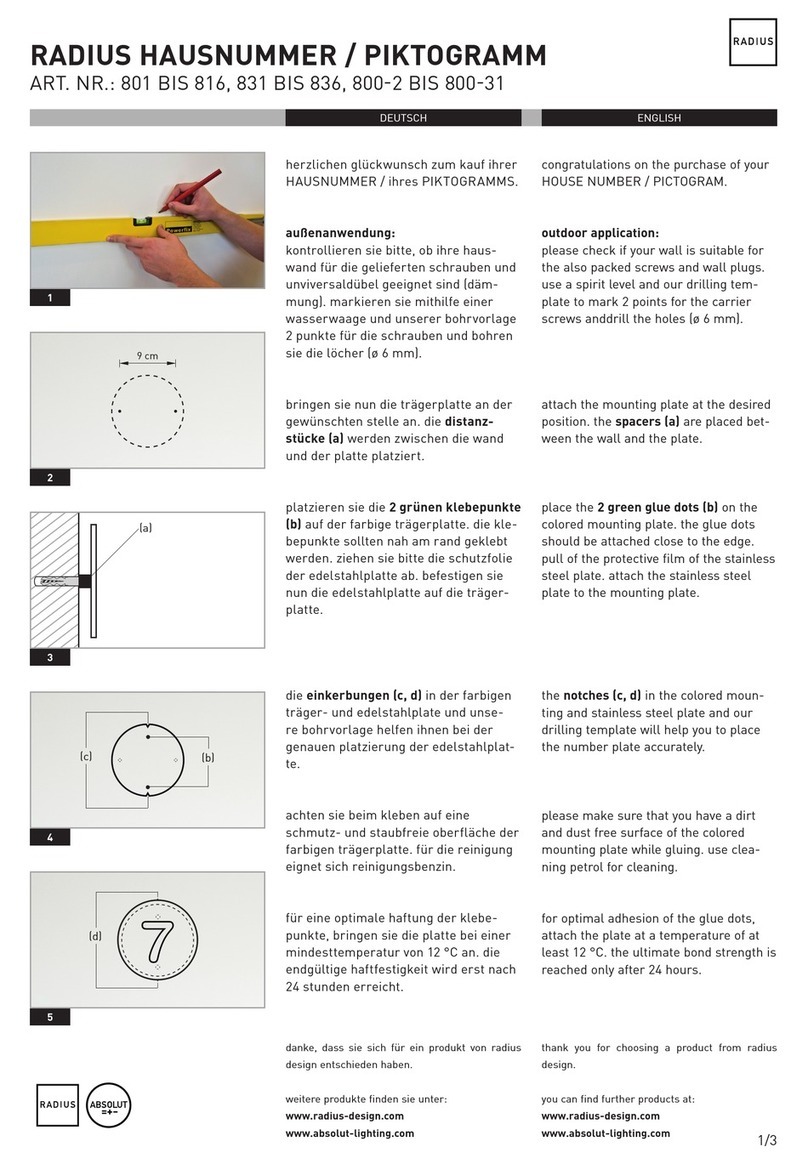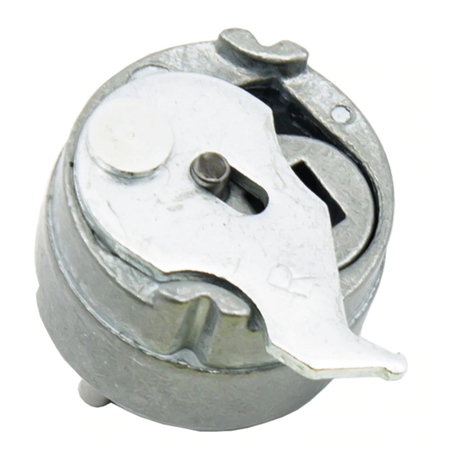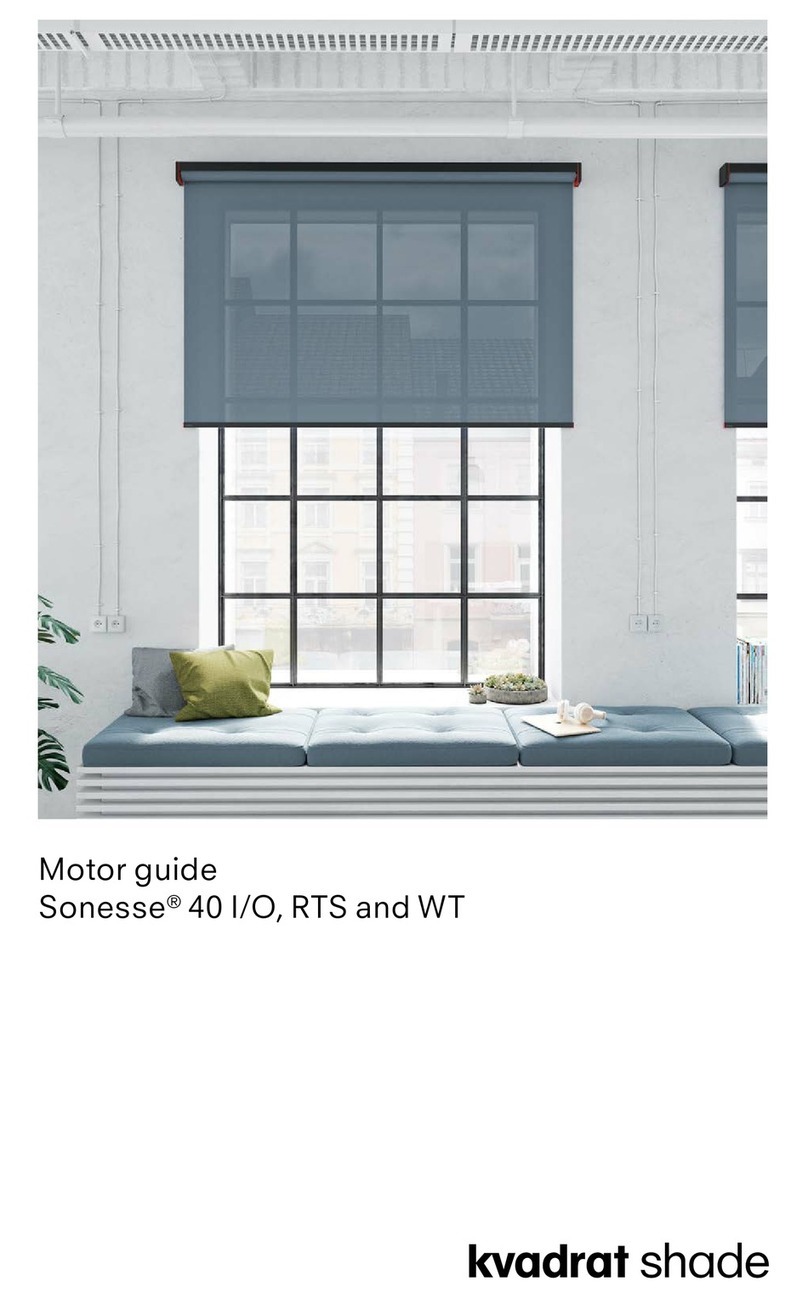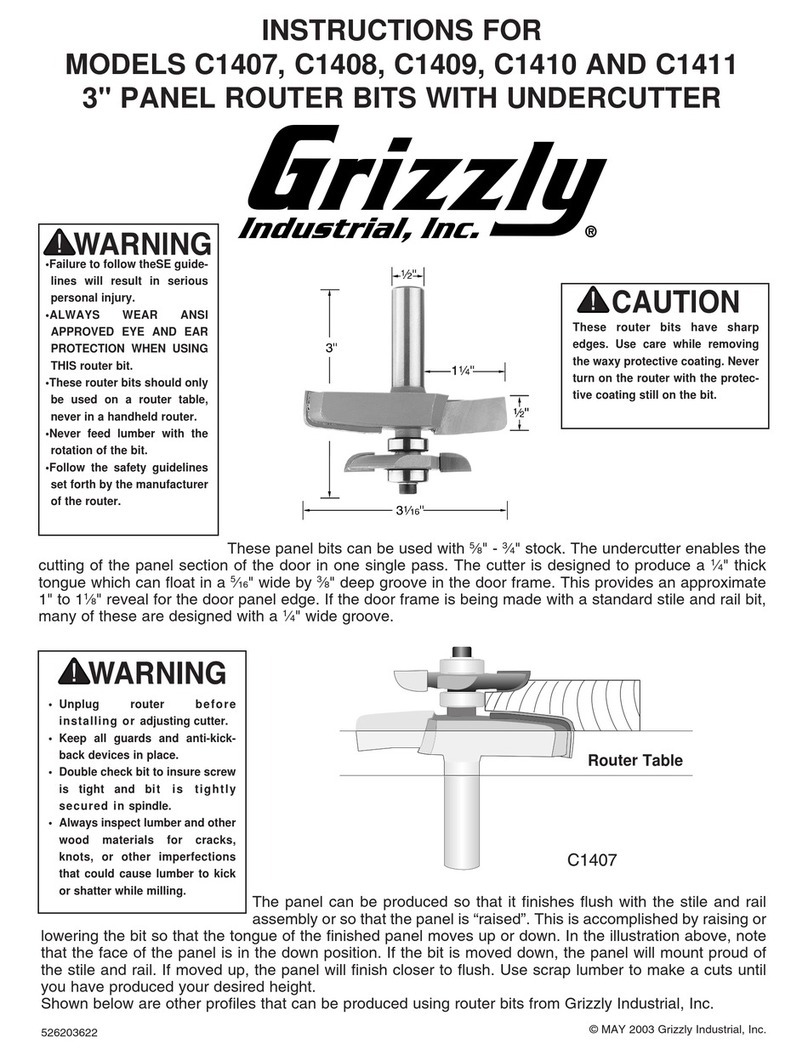Dormakaba TENSOR User manual

WN 059361 45532 – 2017-11
DE | EN
TENSOR Pendeltürband
TENSOR Double action hinge
Montageanleitung
Mounting instructions
Inhalt
1 Über diese Anleitung 2
1.1 Informationen zur Anleitung 2
1.2 Zielgruppe 2
1.3 Verwendete Symbole 2
1.3.1 Sicherheitshinweise 2
1.3.2 Weitere Kennzeichnungen 2
1.3.3 Werkzeugsymbole 2
2 Sicherheit 2
2.1 Bestimmungsgemäße Verwendung und
vorherseh-barer Fehlgebrauch 2
2.1.1 Vorgaben für den Einbauort 2
2.1.2 Vorgaben für den Glastürflügel 3
2.2 Anforderungen an die Wand und an das
Befestigungs-material 3
2.3 Allgemeine Sicherheitshinweise 3
2.4 Chargenkennzeichen 3
3 Produktbeschreibung 3
3.1 Funktionsprinzip 3
3.2 Produktvarianten 3
3.2.1 Wandbefestigung mit aufliegender
Montageplatte 3
3.2.1.1 Lieferumfang 3
3.2.1.2 Maße der Glasbearbeitungen 4
3.2.1.3 Werkzeuge für die Montage 4
3.2.2 Zargenbefestigung mit eingelassener
Montageplatte 4
3.2.2.1 Lieferumfang 4
3.2.2.2 Maße der Glasbearbeitungen 4
3.2.2.3 Werkzeuge für die Montage 4
3.2.3 Glas an Glas-Befestigung 4
3.2.3.1 Lieferumfang 5
3.2.3.2 Maße der Glasbearbeitungen 5
3.2.3.3 Werkzeuge für die Montage 5
4 Montage 5
4.1 Dicke der Zwischenlage bestimmen 5
4.2 Wandbefestigung mit aufliegender
Montageplatte 5
4.2.1 Glastürflügel prüfen 5
4.2.2 Pendeltürband vorbereiten 5
4.2.3 Montageplatten befestigen 6
4.2.4 Glasflächen reinigen 6
4.2.5 Pendeltürband am Glastürflügel
befestigen 6
4.2.6 Glastürflügel an Wand montieren 6
4.3 Zargenbefestigung mit eingelassener
Montageplatte 7
4.3.1 Glastürflügel prüfen 7
4.3.2 Türzarge vorbereiten 7
4.3.3 Pendeltürband vorbereiten 7
4.3.4 Montageplatten befestigen 7
4.3.5 Pendeltürband an der Zarge befestigen 8
4.3.6 Glasflächen reinigen 8
4.3.7 Glastürflügel positionieren und
festschrauben 8
4.4 Glas an Glas-Befestigung 8
4.4.1 Seitenteil montieren 8
4.4.2 Glastürflügel und Seitenteil prüfen 9
4.4.3 Pendeltürband vorbereiten 9
4.4.4 Glasflächen reinigen 9
4.4.5 Glastürflügel an Seitenteil befestigen 9
4.5 Überdrehen der Tür verhindern 10
5 Nulllage einstellen 10
6 Wartung und Pflege 11
6.1 Pendeltürband warten 11
6.2 Reinigungshinweis 11
7 Demontage und Entsorgung 11
DE

1 Über diese Anleitung
1.1 Informationen zur Anleitung
Diese Anleitung beschreibt die Montage der TENSOR
Pendeltürbänder und enthält Informationen zur
Wartung und Pflege.
1.2 Zielgruppe
Der Einbau von dormakaba-Glasbeschlägen darf
ausschließlich durch Fachpersonal, das speziell für
die Glasmontage geschult wurde, erfolgen.
1.3 Verwendete Symbole
1.3.1 Sicherheitshinweise
Sicherheitshinweise sind durch Symbole
gekennzeichnet. Die Sicherheitshinweise werden
durch Signalworte eingeleitet, die das Ausmaß der
Gefährdung zum Ausdruck bringen.
Symbol in
Anleitung
Signalwort Folge
VORSICHT
Weist auf eine mög-
licherweise gefährliche
Situation hin, die zu
leichten Verletzungen
führen kann, wenn sie
nicht gemieden wird
ACHTUNG
Weist auf eine mög-
licherweise gefährliche
Situation hin, die zu
Sachbeschädigungen
führen kann, wenn sie
nicht gemieden wird
1.3.2 Weitere Kennzeichnungen
2.1. Handlungsschritte in Grafiken
1 2 Positionsnummern von Bauteilen
in Grafiken
1.3.3 Werkzeugsymbole
Bohrmaschine
Drehmomentschlüssel (Art.-Nr. 07.624)
Wasserwaage
Inbusschlüssel z. B. Schlüsselweite SW 3
2 Sicherheit
2.1 Bestimmungsgemäße
Verwendung und vorherseh-
barer Fehlgebrauch
Die TENSOR Pendeltürbänder sind ausschließlich für
den lotrechten Einbau geeignet.
Die Glastürflügel dürfen nicht aufgestoßen werden,
sondern müssen von Hand geführt werden. Der
Glastürflügel schließt selbstständig. Die
Rückstellmechanik kann Funktionsgeräusche
verursachen. Der Glastürflügel darf nicht zugeworfen
werden. Der maximale Türöffnungswinkel der
Pendeltüren beträgt 90° Grad in jede
Öffnungsrichtung. Die Pendeltüren müssen bauseits
vor größeren Öffnungswinkeln geschützt werden, z. B.
durch Türstopper.
Abb. 1 Pendeltür mit bauseitigen Türstoppern in jede
Öffnungsrichtung
Die TENSOR Pendeltürbänder sind nicht geeignet für
Anschlagtüren.
Abb. 2 Falsche Verwendung als Anschlagtür
2.1.1 Vorgaben für den Einbauort
Die TENSOR Pendeltürbänder sind nur für den
trockenen Innenbereich geeignet.
Die TENSOR Pendeltürbänder sind nicht geeignet im
Bereich von Dusche, Sauna, Schwimm- und Solebad
oder Räumen, in denen Chemikalien (z. B. Chlor) zum
Einsatz kommen.
Abb. 3 Nicht geeignet im Bereich von Dusche, Sauna-
Schwimm- und Solebad
2TENSOR 2017-11
WN 059361 45532
dormakaba Montageanleitung Über diese Anleitung

3 Produktbeschreibung
3.1 Funktionsprinzip
Die TENSOR Pendeltürbänder klemmen den
Glastürflügel zwischen der Trage- und der
Gegenplatte fest. Verschiedene Glasdicken werden
durch Zwischenlagen ausgeglichen.
3.2 Produktvarianten
Es gibt 3 Produktvarianten für unterschiedliche
Einbausituationen.
3.2.1 Wandbefestigung mit
aufliegender Montageplatte
Abb. 5 Spaltmaße für Wandbefestigung mit aufliegender
Montageplatte
3.2.1.1 Lieferumfang
2 x Pendeltürband (Abb. 6/1)
Zwischenlagen je 4 x in 3 verschiedenen Dicken:
1 mm, 2 mm, 3 mm (Abb. 6/2)
12 x Anschlagkappe in 3 verschiedenen
Farben (Abb. 6/3)
8 x Senkschraube M6 x 12 (Abb. 6/4)
2 x Montageplatte (Abb. 6/5)
Abb. 6
1
3
45
2
Lieferumfang der Wandbefestigung mit aufliegender
Montageplatte
2.1.2 Vorgaben für den
Glastürflügel
dormakaba empfiehlt die Verwendung von ESG-H
(heißgelagertem Einscheibensicherheitsglas) nach
DIN EN 12150-1.
Glasdicke 8, 10 oder 12 mm.
Keine selbstreinigenden Beschichtungen.
Strukturierte Glasoberflächen oder Gläser mit
großen Schwankungen in der Glasdicke nur mit
Auftrag einer Ausgleichsschicht.
Keine Gläser mit Ausmuschelungen und/oder
Kantenverletzungen.
2.2 Anforderungen an die Wand
und an das Befestigungs-
material
Die Unterkonstruktion/Wand muss dauerhaft
tragfähig, plan- und lotrecht sein.
Das Befestigungsmaterial muss für die Unter-
konstruktion/Wand geeignet und für das Tür-
flügelgewicht passend dimensioniert sein. Das
Befestigungsmaterial ist nicht im Lieferumfang
enthalten.
Die technischen Hinweise des Befestigungs-
materials beachten.
2.3 Allgemeine
Sicherheitshinweise
Montage muss von zwei Personen ausgeführt
werden.
Schutzkleidung tragen.
Glastürflügel zum Lagern auf Holz stellen und
gegen Umfallen sichern.
Einbauort sichern.
2.4 Chargenkennzeichen
Das Chargenkennzeichen darf nicht abgelöst oder
beschädigt werden, andernfalls erlischt die
Gewährleistung.
Abb. 4 Chargenkennzeichnung am TENSOR Pendeltürband
3TENSOR 2017-11WN 059361 45532
dormakaba Montageanleitung Produktbeschreibung

3.2.1.2 Maße der
Glasbearbeitungen
Glashöhe GH = LH - 10 mm
Glasbreite GB = LW - 6 mm
Abb. 7 Glasbearbeitungen für die Wandbefestigung mit
aufliegender Montageplatte
3.2.1.3 Werkzeuge für die
Montage
Bohrmaschine
Wasserwaage
Inbusschlüssel Schlüsselweite SW 3, 4, 5
Drehmomentschlüssel (Art.-Nr. 07.624)
3.2.2 Zargenbefestigung mit
eingelassener
Montageplatte
Abb. 8 Spaltmaße für Zargenbefestigung mit eingelassener
Montageplatte
3.2.2.1 Lieferumfang
2 x Pendeltürband (Abb. 9/1)
Zwischenlagen je 4 x in 3 verschiedenen Dicken:
1 mm, 2 mm, 3 mm (Abb. 9/2)
12 x Anschlagkappe in 3 verschiedenen
Farben (Abb. 9/3)
4 x Senkschraube M8 x 16 (Abb. 9/4)
8 x Senkschraube M6 x 12 (Abb. 9/5)
2 x Montageplatte (Abb. 9/6)
Abb. 9
1
3
56
4
2
Lieferumfang der Zargenbefestigung mit eingelassener
Montageplatte
3.2.2.2 Maße der
Glasbearbeitungen
Glashöhe GH = LH - 10 mm
Glasbreite GB = LW - 6 mm
Abb. 10 Glasbearbeitungen für die Zargenbefestigung mit
eingelassener Montageplatte
3.2.2.3 Werkzeuge für die
Montage
Bohrmaschine
Wasserwaage
Inbusschlüssel Schlüsselweite SW 3, 4, 5
Drehmomentschlüssel (Art.-Nr. 07.624)
3.2.3 Glas an Glas-Befestigung
Abb. 11 Spaltmaße für Glas an Glas-Befestigung
4TENSOR 2017-11
WN 059361 45532
dormakaba Montageanleitung Produktbeschreibung

3.2.3.1 Lieferumfang
2 x Pendeltürband (Abb. 12/1)
Zwischenlagen Seitenteil je 4 x in 3 verschiedenen
Dicken: 1 mm, 2 mm, 3 mm (Abb. 12/2)
Zwischenlagen Glastürflügel je 4 x in 3 verschie-
denen Dicken: 1 mm, 2 mm, 3 mm (Abb. 12/3)
12 x Anschlagkappe in 3 verschiedenen
Farben (Abb. 12/4)
Abb. 12
1
2
34
Lieferumfang der Glas an Glas-Befestigungl
3.2.3.2 Maße der
Glasbearbeitungen
Glashöhe GH = LH - 10 mm
Glasbreite GB = LW - 6 mm
Abb. 13 Glasbearbeitungen für die Glas an Glas-Befestigung
3.2.3.3 Werkzeuge für die
Montage
Wasserwaage
Inbusschlüssel Schlüsselweite SW 3, 4, 5
Drehmomentschlüssel (Art.-Nr. 07.624)
4 Montage
4.1 Dicke der Zwischenlage
bestimmen
Für alle Produktvarianten gilt: Je nach Glasdicke
müssen die passenden Zwischenlagen entsprechend
nachfolgender Tabelle ausgewählt und verwendet
werden.
Glasdicke 12 mm 10 mm 8 mm
Zwischenlagen 1 mm 2 mm 3 mm
4.2 Wandbefestigung mit
aufliegender Montageplatte
4.2.1 Glastürflügel prüfen
VORSICHT
Verletzungsgefahr durch Glasbruch
Schneiden/Abschneiden der Finger an
schneidenden Teilen vom Glasbruch.
Schutzhandschuhe anziehen.
1. Den Glastürflügel auf Beschädigungen prüfen,
z. B. auf Ausmuschelungen und/oder Kantenver-
letzungen. Glastürflügel mit Beschädigungen
nicht verbauen.
2. Die Maße der Glasbearbeitung prüfen, siehe
Abb. 7 auf S. 4.
4.2.2 Pendeltürband vorbereiten
1. Die Gegenplatte (Abb. 14/1) abschrauben.
2. Die passenden Zwischenlagen (Abb. 14/2) nach
der Glasdicke auswählen (siehe Tabelle Kapitel 4).
3. Die Schutzfolien der Klebestreifen auf der Trage-
und der Gegenplatte (Abb. 14/1 und Abb. 14/3)
abziehen.
Abb. 14
2.
3.
1.
1
2
3
Vorbereitung des Pendeltürbands
4. Die Zwischenlagen auf die Trage- und die Gegen-
platte kleben.
5TENSOR 2017-11WN 059361 45532
dormakaba Montageanleitung Montage

4.2.3 Montageplatten befestigen
1. Die Montageplatte mit 4 Senkschrauben (M6 x 12)
an das TENSOR Pendeltürband befestigen
(Abb. 15).
2. Die Schrauben auf festen Sitz prüfen. Das
Anzugsmoment 12 Nm beachten.
Abb. 15 Befestigung der Montageplatten am Pendeltürband
4.2.4 Glasflächen reinigen
Die Glasflächen im Bereich der Klemmflächen
reinigen. Dazu handelsüblichen Glasreiniger
verwenden. Keine Verdünnung verwenden!
4.2.5 Pendeltürband am
Glastürflügel befestigen
1. Die Glastür auf Montageböcke legen.
2. Die vorbereiteten TENSOR Pendeltürbänder in die
Glasausschnitte setzen und ausrichten.
3. Die Gegenplatten montieren. Das Anzugsmoment
15 Nm beachten.
Abb. 16 Befestigung des Pendeltürbands am Glastürflügel
4.2.6 Glastürflügel an Wand
montieren
ACHTUNG
Gefahr der Beschädigung des Glastürflügels
durch Kontakt mit harten Werkstoffen (z. B.
Glas, Metall, Beton)
Der Kontakt kann zu Ausmuschelungen,
Kantenverletzungen und/oder Glasbruch des
Glastürflügels führen.
Beschädigte Glastürflügel dürfen nicht
verbaut werden – Verletzungsgefahr.
Glaskanten mit Abstandhaltern schützen!
1. Die Glastürflügel an der Montagepositon
auf Holzklötze o. Ä. aufstellen und lotrecht
ausrichten. Die Spaltmaße beachten (siehe
Abb. 5 auf S. 3)
Abb. 17 Senkrechte und lotrechte Montageposition der
Pendeltürbänder
2. Das Bohrbild vom oberen und unteren
Pendeltürband anzeichnen.
Abb. 18 Bohrbild des Pendeltürbands
3. Die Glastürflügel entfernen und auf Holzklötzen o.
Ä. zwischenlagern.
4. Die Löcher bohren. Durchmesser entsprechend
den Technischen Hinweisen des gewählten
Befestigungsmaterials.
5. Den Glastürflügel positionsgenau aufstellen.
6. Wenn die Montageplatten bei lotrechter Position
des Glastürflügels nicht an der Wand anliegen,
dann die Montageplatten unterfüttern.
6TENSOR 2017-11
WN 059361 45532
dormakaba Montageanleitung Montage

7. Die Montageplatten mit verzinkten Senk- oder
Senkholzschrauben M6 nach DIN 7991 bzw.
DIN 7997 festschrauben.
8. Alle Montageklötze entfernen.
Abb. 19
7.
8.
Montage des Pendeltürbands an der Wand
4.3 Zargenbefestigung mit
eingelassener Montageplatte
4.3.1 Glastürflügel prüfen
VORSICHT
Verletzungsgefahr durch Glasbruch
Schneiden/Abschneiden der Finger an
schneidenden Teilen vom Glasbruch.
Schutzhandschuhe anziehen.
1. Den Glastürflügel auf Beschädigungen prüfen,
z. B. Ausmuschelungen und/oder Kantenver-
letzungen. Glastürflügel mit Beschädigungen
nicht verbauen.
2. Die Maße der Glasbearbeitung prüfen, siehe
Abb. 10 auf S. 4.
4.3.2 Türzarge vorbereiten
1. Die Aussparungen für die Montageplatten in der
Zarge lotrecht anzeichnen. Maße A und B siehe
Abb. 10 auf S. 4.
2. 4 mm tiefe Aussparungen für die Montageplatte
in der Zarge ausnehmen.
Abb. 20 Maßbild für Aussparungen der Montageplatten in der
Zarge
4.3.3 Pendeltürband vorbereiten
1. Die Gegenplatte (Abb. 21/1) abschrauben.
2. Die passenden Zwischenlagen (Abb. 21/2)
nach der Glasdicke auswählen (siehe Tabelle
Kapitel 4.1).
3. Die Schutzfolien der Klebestreifen auf der Trage-
und der Gegenplatte (Abb. 21/1 und Abb. 21/3)
abziehen.
Abb. 21
2.
3.
1.
1
2
3
Vorbereitung des Pendeltürbands
4. Die Zwischenlagen auf die Trage- und die Gegen-
platte kleben.
4.3.4 Montageplatten befestigen
1. Die Senkschrauben M8 x 16 in die vorbereiteten
Senkungen der Montageplatte stecken.
2. Die Montageplatte mit vier Senkschrauben
(M6 x 12) an dem TENSOR Pendeltürband
befestigen. Das Anzugsmoment 12 Nm beachten.
Abb. 22
2.
1.
Befestigung der Montageplatten am Pendeltürband
7TENSOR 2017-11WN 059361 45532
dormakaba Montageanleitung Montage

4.3.5 Pendeltürband an der Zarge
befestigen
1. Die Pendeltürbänder mit den Senkschrauben
M8 x 16 in der vorbereiteten Zarge befestigen.
2. Das Anzugsmoment 20 Nm beachten.
Abb. 23 Montage der Pendeltürbänder in der Zarge
4.3.6 Glasflächen reinigen
Die Glasflächen im Bereich der Klemmflächen
reinigen. Dazu handelsüblichen Glasreiniger
verwenden. Keine Verdünnung verwenden!
4.3.7 Glastürflügel positionieren
und festschrauben
ACHTUNG
Gefahr der Beschädigung des Glastürflügels
durch Kontakt mit harten Werkstoffen (z. B.
Glas, Metall, Beton)
Der Kontakt kann zu Ausmuschelungen,
Kantenverletzungen und/oder Glasbruch des
Glastürflügels führen.
Beschädigte Glastürflügel dürfen nicht
verbaut werden – Verletzungsgefahr.
Glaskanten mit Abstandhaltern schützen!
1. Den Glastürflügel an der Montagepositon auf
Holzklötze o. Ä. aufstellen.
2. Die Gegenplatten montieren. Das Anzugsmoment
15 Nm beachten.
3. Alle Montageklötze entfernen.
Abb. 24
2.
3.
1.
Montage des Glastürflügels
4.4 Glas an Glas-Befestigung
4.4.1 Seitenteil montieren
ACHTUNG
Gefahr der Beschädigung des Glastürflügels
durch unzureichende instabile Befestigung
Das Seitenteil muss ausreichend tragfähig
befestigt werden. Eine Silikonfuge zur
Bodenbefestigung ist nicht ausreichend!
dormakaba Wandanschlussprofile oder
dormakaba U-Profil verwenden!
dormakaba empfiehlt die Verwendung des
dormakaba Wandanschlussprofils Art.-Nr.:
07.050/051/052 (Abb. 25/2). Die Bodenbefestigung
kann alternativ mit dem dormaka U-Profil Art.-Nr.:
07.093 ausgeführt werden (Abb. 25/1).
1. Das Seitenteil auf Beschädigungen prüfen, z. B.
Ausmuschelungen und/oder Kantenverletzungen.
Seitenteil mit Beschädigungen nicht verbauen.
2. Das Seitenteil nach der beiliegenden Montage-
anleitung montieren.
Abb. 25
1
2
Montage des Seitenteils
8TENSOR 2017-11
WN 059361 45532
dormakaba Montageanleitung Montage

4.4.2 Glastürflügel und Seitenteil
prüfen
VORSICHT
Verletzungsgefahr durch Glasbruch
Schneiden/Abschneiden der Finger an
schneidenden Teilen vom Glasbruch.
Schutzhandschuhe anziehen.
1. Die Glastürflügel auf Beschädigungen prüfen,
z. B. Ausmuschelungen und/oder
Kantenverletzungen. Glastürflügel mit
Beschädigungen nicht verbauen.
2. Die Maße der Glasbearbeitung prüfen, siehe Abb.
13 auf S. 5.
4.4.3 Pendeltürband vorbereiten
1. Die Gegenplatten (Abb. 26/1) abschrauben .
2. Die passenden Zwischenlagen (Abb. 26/2) nach
Glasdicke auswählen (siehe Tabelle Kapitel 4).
3. Die Schutzfolien der Klebestreifen auf der Trage-
und der Gegenplatte abziehen.
Abb. 26
2.
3.
3.
1.
1.
1
1
2
Vorbereitung des Pendeltürbands
4. Die Zwischenlagen auf die Trage- und die Gegen-
platte kleben.
4.4.4 Glasflächen reinigen
Die Glasflächen im Bereich der Klemmflächen
reinigen. Dazu handelsüblichen Glasreiniger
verwenden. Keine Verdünnung verwenden!
4.4.5 Glastürflügel an Seitenteil
befestigen
ACHTUNG
Gefahr der Beschädigung des Glastürflügels
durch Kontakt mit harten Werkstoffen (z. B.
Glas, Metall, Beton)
Der Kontakt kann zu Ausmuschelungen,
Kantenverletzungen und/oder Glasbruch des
Glastürflügels führen.
Beschädigte Glastürflügel dürfen nicht
verbaut werden – Verletzungsgefahr.
Glaskanten mit Abstandhaltern schützen!
1. Die Pendeltürbänder in die Glasauschnitte im
Seitenteil waagerecht einsetzen.
2. Die Gegenplatten der Pendeltürbänder mit den
Klemmschrauben leicht festziehen.
Abb. 27
1.
2.
Montage des Pendeltürbands an das Seitenteil
3. Den Glastürflügel an der Montagepositon
auf Holzklötze o. Ä. aufstellen und lotrecht
ausrichten. Die Spaltmaße beachten (siehe
Abb. 11 auf S. 4)
4. Die Gegenplatten anschrauben. Das
Anzugsmoment 15 Nm beachten!
Abb. 28
4.
Montage des Glastürflügels an Pendeltürband
9TENSOR 2017-11WN 059361 45532
dormakaba Montageanleitung Montage

5. Die Klemmschrauben des Seitenteils festziehen.
Das Anzugsmoment 15 Nm beachten!
6. Alle Montageklötze entfernen!
Abb. 29
5.
6.
Montage des Glastürflügels
4.5 Überdrehen der Tür
verhindern
Die Pendeltür darf max. 90° geöffnet werden. Das
Überdrehen der Tür verhindern, z. B. durch Türstopper.
Abb. 30 Türstopper gegen Überdrehen
5 Nulllage einstellen
Die Nulllage ist die Voraussetzung für die Selbst-
schließfunktion. Die Nulllage ist die Türflügelposition
bei geschlossener Tür. Die Pendeltürbänder werden
mit nicht eingestellter Nulllage geliefert.
1. Alle Montageklötze oder Ähnliches entfernen.
2. Den Glastürflügel in die ideale Nulllage bringen
(Abb. 31).
Abb. 31 Ideale Nulllage vom Glastürflügel zum Seitenteil
3. Alle Schrauben (2 x oberes Band und
2 x unteres Band) anziehen. Das Anzugsmoment
5 Nm beachten (Abb. 32)!
Abb. 32 Lage der Schrauben
4. Die Pendelbewegung der Tür abschließend prüfen.
Wenn der Glastürflügel nicht in der idealen
Nulllage schließt, Schrauben wieder lösen und die
Nulllage erneut einstellen.
5. Anschlagkappen eindrücken.
Abb. 33 Montage der Anschlagkappen
10 TENSOR 2017-11
WN 059361 45532
dormakaba Montageanleitung Nulllage einstellen

6 Wartung und Pflege
6.1 Pendeltürband warten
Den Sitz und die Gängigkeit der Beschläge sowie die
Justierung der Tür regelmäßig kontrollieren. Im Fall
von hochfrequentierten Anlagen die Prüfung von
einem Fach- oder Installationsbetrieb durchführen
lassen. Für eine lange, störungsfreie Lebensdauer des
TENSOR Pendeltürbands empfiehlt dormakaba eine
jährliche Wartung durch Fachpersonal. Wenn 100.000
Bewegungszyklen vor Ablauf eines Jahres erreicht
werden, die Wartung vorziehen.
1. Im Rahmen der Wartung die Laufbuchsen am
Drehpunkt leicht mit einem silikon-, harz-, teflon-
und säurefreien Multifunktionsöl schmieren.
Abb. 34
1.
1.
Schmierung der Laufbuchsen am Drehpunkt
2. Glasflügel auf Abplatzungen und/oder Aus-
muschelungen prüfen. Beschädigte Glasflügel
unverzüglich austauschen.
6.2 Reinigungshinweis
Die Reinigung der Oberflächen darf nur mit
geeigneten Reinigern und Pflegemitteln erfolgen.
7 Demontage und
Entsorgung
Die Demontage erfolgt in umgekehrter Reihenfolge
der Montageanleitung und muss durch sachkundiges
Personal erfolgen. Bei der Entsorgung die ein-
schlägigen nationalen Normen und Richtlinien
beachten.
11TENSOR 2017-11WN 059361 45532
dormakaba Montageanleitung Wartung und Pflege

DORMA-Glas GmbH
Max-Planck-Straße 33 – 45 32107 Bad Salzuflen Deutschland T: +49 2333 793-0 F: +49 2333 793-4950 www.dormakaba.com
012859 – Änderungen vorbehalten

EN
Contents
1 About these instructions 14
1.1 Information about the instructions 14
1.2 Target group 14
1.3 Symbols used 14
1.3.1 Safety instructions 14
1.3.2 Further markings 14
1.3.3 Tool icons 14
2 Safety 14
2.1 Proper use and foreseeable misuse 14
2.1.1 Specifications for the installation
location 14
2.1.2 Specifications for the glass door leaf 15
2.2 Requirements for the wall and the mounting
material 15
2.3 General safety instructions 15
2.4 Identification label 15
3 Product description 15
3.1 Principle of operation 15
3.2 Product variants 15
3.2.1 Wall mounting with surface mounted
mounting plate 15
3.2.1.1 Scope of delivery 15
3.2.1.2 Size of glass preparations 16
3.2.1.3 Tools for mounting 16
3.2.2 Frame with embedded mounting plate 16
3.2.2.1 Scope of delivery 16
3.2.2.2 Size of glass preparations 16
3.2.2.3 Tools for mounting 16
3.2.3 Glass to glass mounting 16
3.2.3.1 Scope of delivery 17
3.2.3.2 Size of glass preparations 17
3.2.3.3 Tools for mounting 17
4 Mounting 17
4.1 Determine the thickness of the gasket 17
4.2 Wall mounting with surface mounted
mounting plate 17
4.2.1 Check the glass door leaf 17
4.2.2 Prepare the double action hinge 17
4.2.3 Fix mounting plates 18
4.2.4 Clean glass surfaces 18
4.2.5 Attach the double action hinge onto
the glass door leaf 18
4.2.6 Mount the glass door leaf onto the
wall 18
4.3 Frame with embedded mounting plate 19
4.3.1 Check the glass door leaf 19
4.3.2 Preparing the door frame 19
4.3.3 Prepare the double action hinge 19
4.3.4 Fix mounting plates 19
4.3.5 Attach the double action door hinge
to the frame 20
4.3.6 Clean glass surfaces 20
4.3.7 Position and screw in double action
hinges 20
4.4 Glass to glass mounting 20
4.4.1 Mount the side panel 20
4.4.2 Check the glass door leaf and the side
panel 21
4.4.3 Prepare the double action hinge 21
4.4.4 Clean glass surfaces 21
4.4.5 Attach the glass door leaf to the side
panel 21
4.5 Prevent excessive opening of the door 22
5 Adjusting the “0” position 22
6 Maintenance and care 23
6.1 Maintain the double action hinge 23
6.2 Cleaning instructions 23
7 Dismantling and disposal 23
13TENSOR 2017-11WN 059361 45532
dormakaba Mounting instructions Contents

1 About these
instructions
1.1 Information about the
instructions
These instructions describe the mounting of TENSOR
double action hinges and provide information on care
and maintenance.
1.2 Target group
Only properly qualified and specially trained staff are
authorized to mount dormakaba glass fittings.
1.3 Symbols used
1.3.1 Safety instructions
Safety instructions are marked with symbols. The
safety instructions are introduced by signal words
that express the extent of the hazard.
Symbol in the
instructions
Signal word Result
CAUTION
Indicates a potentially
dangerous situation
that can result in
minor injuries if it is
not avoided.
ATTENTION
Indicates a potentially
dangerous situation
that can lead to
property damage if
not avoided.
1.3.2 Further markings
2.1. Action steps in graphics
1 2 Position numbers of components
in graphics
1.3.3 Tool icons
Drill
Torque wrench (Item No. 07.624)
Level
Allen wrench e.g. wrench size SW 3
2 Safety
2.1 Proper use and foreseeable
misuse
TENSOR double action hinges are only suitable for
vertical installation.
Glass door leaves must not be swung open but must
be guided by hand. The glass door closes
automatically. The reset mechanism can cause
operational sounds. The glass door leaf must not be
pushed open. The maximum door opening angle of
double action doors is 90° in each opening direction.
Double action doors must be protected from greater
opening angles on site, e.g. by using a doorstop.
Fig. 35 Double action door with on-site doorstops in any
opening direction
TENSOR double action hinges are not suitable for
single action doors.
Fig. 36 Incorrect use as a single action door
2.1.1 Specifications for the
installation location
TENSOR double action hinges are only suitable for dry
indoors spaces.
TENSOR double action hinges are not suitable for
showers, sauna, bath or salt-water bath applications
or rooms where chemicals (e. g. chlorine) are used.
Fig. 37 Not suitable for showers, sauna, bath or salt-water
bath
14 TENSOR 2017-11
WN 059361 45532
dormakaba Mounting instructions About these instructions

3 Product description
3.1 Principle of operation
TENSOR double action hinges secure the glass door
leaf between the base and the counter plate. The
varying glass thickness is compensated by gaskets.
3.2 Product variants
There are 3 product variants for different installation
situations.
3.2.1 Wall mounting with surface
mounted mounting plate
Fig. 39 Gaps for wall mounting with surface mounted
mounting plate
3.2.1.1 Scope of delivery
2 x double action hinge (Fig. 40/ 1)
Gaskets each 4 x with 3 various thickness levels:
1 mm, 2 mm, 3 mm (Fig. 40/ 2)
12 x cover cap in 3 different colors (Fig. 40/ 3)
8 x countersunk screw M6 x 12 (Fig. 40/ 4)
2 x mounting plate (Fig. 40/ 5)
Fig. 40
1
3
45
2
Scope of delivery for the wall mounting with surface
mounted mounting plate
2.1.2 Specifications for the glass
door leaf
dormakaba recommends using TSG-H (heat soaked
toughened safety glass) according to DIN EN 12150-1.
Glass thickness 8, 10 or 12 mm.
No self-cleaning coatings.
No glass surfaces of heavily varying thickness.
No glass with conchoidal fractures and/or damaged
edges.
2.2 Requirements for the wall and
the mounting material
The substructure/wall must be permanently
sustainable, flat and vertical.
The mounting material must be suitable for the
substructure/wall and its dimensions must fit the
door leaf weight. The mounting material is not
included in delivery.
Refer to the technical specifications of the
mounting material.
2.3 General safety instructions
Mounting must be carried out by two people.
Protective clothing must be worn.
Place glass door leaves on wood for storage and
prevent it from falling.
Secure the installation site.
2.4 Identification label
No further warranty is provided if the identification
label has been damaged or removed.
Fig. 38 Identification label on the TENSOR double action hinge
15TENSOR 2017-11WN 059361 45532
dormakaba Mounting instructions Product description

3.2.1.2 Size of glass preparations
Glass height GH = LH - 10 mm
Glass width GW = LW - 6 mm
Fig. 41 Glass preparations for wall mounting with surface
mounted mounting plate
3.2.1.3 Tools for mounting
Drill
Level
Allen wrench, wrench size SW 3, 4, 5
Torque wrench (Item No. 07.624)
3.2.2 Frame with embedded
mounting plate
Fig. 42 Gaps for the frame with embedded mounting plate
3.2.2.1 Scope of delivery
2 x double action hinge (Fig. 43/ 1)
Gaskets each 4 x with 3 various thickness levels:
1 mm, 2 mm, 3 mm (Fig. 43/ 2)
12 x cover cap in 3 different
colors (Fig. 43/ 3)
4 x countersunk screw M8 x 16 (Fig. 43/ 4)
8 x countersunk screw M6 x 12 (Fig. 43/ 5)
2 x mounting plate (Fig. 43/ 6)
Fig. 43
1
3
56
4
2
Scope of delivery for the frame with embedded
mounting plate
3.2.2.2 Size of glass preparations
Glass height GH = LH - 10 mm
Glass width GW = LW - 6 mm
Fig. 44 Glass preparations for the frame with embedded
mounting plate
3.2.2.3 Tools for mounting
Drill
Level
Allen wrench, wrench size SW 3, 4, 5
Torque wrench (Item No. 07.624)
3.2.3 Glass to glass mounting
Fig. 45 Gaps for glass to glass mounting
16 TENSOR 2017-11
WN 059361 45532
dormakaba Mounting instructions Product description

3.2.3.1 Scope of delivery
2 x double action hinge (Fig. 46/ 1)
Gaskets side panel each 4 x in 3 different thickness
levels: 1 mm, 2 mm, 3 mm (Fig. 46/ 2)
Gaskets glass door leaf each 4 x with 3 various
thickness levels: 1 mm, 2 mm, 3 mm (Fig. 46/ 3)
12 x cover cap in 3 different
colors (Fig. 46/ 4)
Fig. 46
1
2
34
Scope of delivery of the glass to glass mounting|
3.2.3.2 Size of glass preparations
Glass height GH = LH - 10 mm
Glass width GW = LW - 6 mm
Fig. 47 Glass preparations for the glass to glass mounting
3.2.3.3 Tools for mounting
Level
Allen wrench, wrench size SW 3, 4, 5
Torque wrench (Item No. 07.624)
4 Mounting
4.1 Determine the thickness of
the gasket
The following applies for all product variants:
Depending on the glass thickness, the suitable
gaskets must be selected and used according to the
following table.
Glass thickness 12 mm 10 mm 8 mm
Gaskets 1 mm 2 mm 3 mm
4.2 Wall mounting with surface
mounted mounting plate
4.2.1 Check the glass door leaf
CAUTION
Risk of injury from broken glass: cutting/
cutting off the fingers on sharp parts of
broken glass.
Wear protective gloves.
1. Check the glass door for damage, e.g. glass for
conchoidal fractures and/or damaged edges. Do
not install damaged glass door leaves.
2. Check the dimensions of glass preparation, see
Fig. 41 on p. 16.
4.2.2 Prepare the double action
hinge
1. Disassemble the counter plate (Fig. 48/1).
2. Select the appropriate gaskets (Fig. 48/2)
according to the glass thickness (see Table in
Chapter 4).
3. Peel off the protection film of the adhesive tape
on the base and counter plate (Fig. 48/1 and Fig.
48/3).
Fig. 48
2.
3.
1.
1
2
3
Preparing the double action hinge
4. Fix the gasket onto the base and counter plate.
17TENSOR 2017-11WN 059361 45532
dormakaba Mounting instructions Mounting

4.2.3 Fix mounting plates
1. Attach the mounting plate with 4 countersunk
screws (M6 x 12) to the TENSOR double action
hinge (Fig. 49).
2. Check that the screws are tight. Tightening is
12Nm.
Fig. 49 Attaching the mounting plates to the double action
hinge
4.2.4 Clean glass surfaces
Clean glass surfaces around the clamping areas. Use
commercial glass cleaner. Do not use thinners!
4.2.5 Attach the double action
hinge onto the glass door
leaf
1. Set the glass door onto assembling trestle.
2. Place the prepared TENSOR double action hinges
into glass cutout and align.
3. Mount counter plates. Tightening is 15 Nm.
Fig. 50 Mounting the double action hinge onto the glass door
leaf
4.2.6 Mount the glass door leaf
onto the wall
ATTENTION
Risk of damage to the glass door leaf by
contact with hard materials (e.g. glass,
metal, concrete)
The contact may cause conchoidal fractures,
damage the edges and/or break the glass
off the glass door.
Damaged glass door leaves should not be
installed – risk of injury. Protect glass edges
with spacers!
1. Place the glass door leaf at the mounting position
on wooden blocks or similar objects and align
vertically. Observe the gaps (see Fig. 39 on p.
15)
Fig. 51 Vertical and perpendicular mounting position of the
double action hinge
2. Mark the drilling pattern of the upper and lower
double action hinge.
Fig. 52 Drilling pattern of the double action hinge
3. Remove glass door leafs and place them on
wooden blocks or similar objects.
4. Drill the holes. Diameter corresponding to the
technical notes of the selected mounting material.
5. Place the glass door leaf in the correct position.
6. Plumb the mounting plates if they do not abut
against the wall in the vertical position of the
glass door leaf.
18 TENSOR 2017-11
WN 059361 45532
dormakaba Mounting instructions Mounting

7. Screw in the mounting plates with galvanized lag
or countersunk screws M6 according to DIN 7991
and DIN 7997.
8. Remove all assembly blocks.
Fig. 53
7.
8.
Mounting the double action hinge onto the wall
4.3 Frame with embedded
mounting plate
4.3.1 Check the glass door leaf
CAUTION
Risk of injury from broken glass
Cutting/cutting off the fingers on sharp
parts of broken glass.
Wear protective gloves.
1. Check the glass door leaf for damage, e.g. glass
for conchoidal fractures and/or damaged edges.
Do not install damaged glass door leaves.
2. Check the dimensions of glass preparation, see
Fig. 44 on p. 16.
4.3.2 Preparing the door frame
1. Vertically mark the recesses for the mounting
plates in the frame. Dimensions A and B see Fig.
44 on p. 16.
2. Cut out 4 mm deep recesses for the mounting
plate in the frame.
Fig. 54 Dimensional drawing for mounting plates recesses in
the frame
4.3.3 Prepare the double action
hinge
1. Disassemble the counter plate (Fig. 55/1).
2. Select the appropriate gaskets (Fig. 55/2)
according to the glass thickness (see Table in
Chapter 4.1).
3. Peel off the protection film of the adhesive tape
on the base and counter plate (Fig. 55/1 and Fig.
55/3).
Fig. 55
2.
3.
1.
1
2
3
Preparing the double action hinge
4. Fix the gasket onto the base and counter plate.
4.3.4 Fix mounting plates
1. Place the countersunk screws M8 x 16 into the
prepared counterbore of the mounting plate.
2. Fasten the mounting plate with four countersunk
screws (M6 x 12) to the TENSOR double action
hinge. Tightening is 12 Nm.
Fig. 56
2.
1.
Attaching the mounting plates to the double action
hinge
19TENSOR 2017-11WN 059361 45532
dormakaba Mounting instructions Mounting

4.3.5 Attach the double action
door hinge to the frame
1. Attach double action hinges with countersunk
screws M8 x 16 to the prepared frame.
2. Tightening is 20 Nm.
Fig. 57 Mounting double action hinges into the frame
4.3.6 Clean glass surfaces
Clean glass surfaces around the clamping areas. Use
commercial glass cleaner. Do not use thinners!
4.3.7 Position and screw in double
action hinges
ATTENTION
Risk of damage to the glass door leaf by
contact with hard materials (e.g. glass,
metal, concrete)
The contact may cause conchoidal fractures,
damage the edges and/or break the glass
off the glass door.
Damaged glass door leaves should not be
installed – risk of injury. Protect glass edges
with spacers!
1. Place the glass door leaf at the mounting position
on wooden blocks or similar objects.
2. Mount counter plates. Tightening is 15 Nm.
3. Remove all assembly blocks.
Fig. 58
2.
3.
1.
Mounting the glass door leaf
4.4 Glass to glass mounting
4.4.1 Mount the side panel
ATTENTION
Risk of damage to the glass door leaf by
inadequate, unstable mounting
The side panel must be attached in a
sufficiently stable manner. A simple silicone
seam for the bottom attachment is
insufficient!
Use dormakaba wall connection profile or
dormakaba U-profile!
dormakaba recommends using the dormakaba wall
connection profile part no.: 07.050/051/052 (Fig.
59/2). For the lower edge of the side panel, we
recommend using the Dorma U-profile part no.:
07.093 (Fig. 59/1).
1. Check the side panel for damage, e.g. conchoidal
fractures and/or damaged edges. Do not install a
damaged side panel.
2. Mount the side panel according to the enclosed
mounting instructions.
Fig. 59
1
2
Mounting the side panel
20 TENSOR 2017-11
WN 059361 45532
dormakaba Mounting instructions Mounting
Other manuals for TENSOR
1
Table of contents
Languages:

